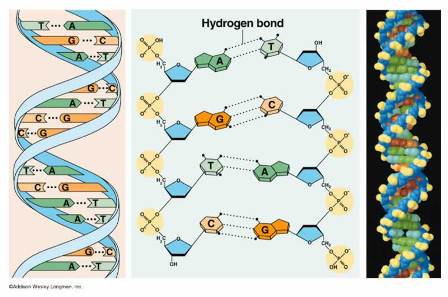B.8 Nucleic acids
Written specifically for students to provide help and support for the IB Diploma chemistry programme this page provides full coverage of the syllabus content of Option B - sub topic B.8. It encourages you to think critically and provides many questions with full worked answers so that you can monitor and improve your knowledge and understanding.

 Learning outcomes
Learning outcomes
 After studying this topic you should be able to:
After studying this topic you should be able to:
Understand:
- Nucleotides are condensation products formed from a pentose sugar, phosphoric acid and a nitrogenous base—adenine (A), guanine (G), cytosine (C), thymine (T) or uracil (U).
- Polynucleotides are formed by condensation reactions.
- DNA comprises a double helix made of two polynucleotide strands bonded together by hydrogen bonds.
- RNA is usually a single polynucleotide chain containing uracil in the place of thymine, and ribose in the place of deoxyribose.
- The sequence of bases in DNA determines the primary structure of proteins which are synthesized by the cell using a universal triplet code, known as the genetic code.
- Genetically modified organisms have genetic material that has been altered by genetic engineering techniques, involving the transfer of DNA between species.
- Explain the stability of DNA in terms of the interactions between its hydrophilic and hydrophobic components.
- Explain the origin of the negative charge on DNA and its association with basic proteins (histones) in chromosomes.
- Deduce the sequence of nucleotides in a complementary strand of DNA or a molecule of RNA from a given polynucleotide sequence.
- Explain how the complementary pairing between bases enables DNA to replicate itself exactly.
- Discuss the benefits and concerns of using genetically modified foods.
Relationships & vocabulary
Nature of science
Scientists used models and diffraction experiments to determine the structure of DNA. This is a good example of the use of different approaches to solve the same problem.
The use of X-ray diffraction provided evidence for the double helix, which led to the explanation of how DNA functions.
International-mindedness
The goal of the Human Genome Project, an international research programme, l was to complete the mapping and sequencing of all the genes in the human genome.
The policies for labelling genetically modified (GM) foods vary greatly from country to country.
What effect does the protection of genetically modified organisms by international patents have on the global economy and scientific community?
Vocabulary
| nucleotide | polynucleotide | adenine | thymine | cytosine |
| guanine | uracil | histone | triplet code | codon |
| deoxyribonucleic acid | DNA (deoxyribonucleic acid) | RNA (ribonucleic acid) | human genome |
Learning slides
You can use this slide gallery for learning or for reviewing concepts and information. It covers all the key points in the syllabus for this sub-topic.
Something to think about
 It's not every day that you find a king buried under a public car park. Archaeologists from Leicester University have confirmed "beyond reasonable doubt" that a skeleton found beneath a car park in Leicester, U.K. is that of the Plantagenet king Richard III who died at the battle of Bosworth Field in 1485. It was known that his body had been buried hastily in the Church of Greyfriars in Leicester. However the church was destroyed in the Reformation in the sixteenth century and the site of the church was lost. So how can a body that has been in the ground for more than five hundred years be positively identified? There is no one definitive piece of evidence but many separate clues which all add up to a near certain confirmation. The skeleton was that of a male in his late twenties or early thirties and Richard III was 32 when he died. There were several wounds on the body including eight to the head, which suggests that the victim died in battle. Carbon dating showed the bones to be from between 1455 and 1540 and there was also evidence of curvature of the spine which fits in with Richard III being the 'hunchback' king. Of relevance to this sub-topic is the DNA profiling evidence. To be able to get DNA from a skeleton that is 500 years old is amazing in itself but by carrying out the profile it has been shown to match living descendants through the maternal line. The BBC has produced a good article detailing how DNA testing works.
It's not every day that you find a king buried under a public car park. Archaeologists from Leicester University have confirmed "beyond reasonable doubt" that a skeleton found beneath a car park in Leicester, U.K. is that of the Plantagenet king Richard III who died at the battle of Bosworth Field in 1485. It was known that his body had been buried hastily in the Church of Greyfriars in Leicester. However the church was destroyed in the Reformation in the sixteenth century and the site of the church was lost. So how can a body that has been in the ground for more than five hundred years be positively identified? There is no one definitive piece of evidence but many separate clues which all add up to a near certain confirmation. The skeleton was that of a male in his late twenties or early thirties and Richard III was 32 when he died. There were several wounds on the body including eight to the head, which suggests that the victim died in battle. Carbon dating showed the bones to be from between 1455 and 1540 and there was also evidence of curvature of the spine which fits in with Richard III being the 'hunchback' king. Of relevance to this sub-topic is the DNA profiling evidence. To be able to get DNA from a skeleton that is 500 years old is amazing in itself but by carrying out the profile it has been shown to match living descendants through the maternal line. The BBC has produced a good article detailing how DNA testing works.
Richard III was reburied in Leicester Cathedral in March 2015. For a controversial account read the article written by Polly Toynbee in the Guardian.
Test your understanding of this topic
(Note that your teacher may have restricted your access to some or all of these questions and worked answers if they are going to use them as a class test or set them as an assignment.)
For ten 'quiz' questions (for quick testing of knowledge and understanding with the answers explained) see MC test: Nucleic acids.
For short-answer questions see Nucleic acids questions together with the worked answers on a separate page Nucleic acids answers.
More resources
1.

A useful image to show the double helix and the hydrogen bonding that occurs between the bases. You can download a similar image of this from Brooklyn.
2. Information on how you can make their own model of DNA. If you are short of cash then there is an interesting article in School Science on how you can make a model using just recycled materials.
3. A TED talk by James Watson on the discovery of DNA and some of today's DNA mysteries.
.
4. A useful podcast from the Royal Society of Chemistry on
5. For a reasonably balanced article on the advantages and disadvantages of GM food see WebMD.
6.
 For those with a real interest in the subject it is well worth reading the personal account of James Watson in his acclaimed book The Double Helix.
For those with a real interest in the subject it is well worth reading the personal account of James Watson in his acclaimed book The Double Helix.

 IB Docs (2) Team
IB Docs (2) Team 




















